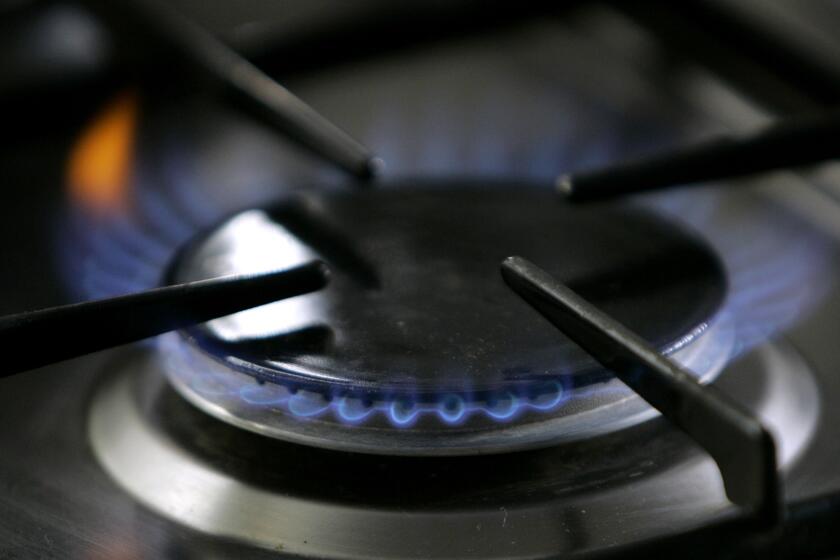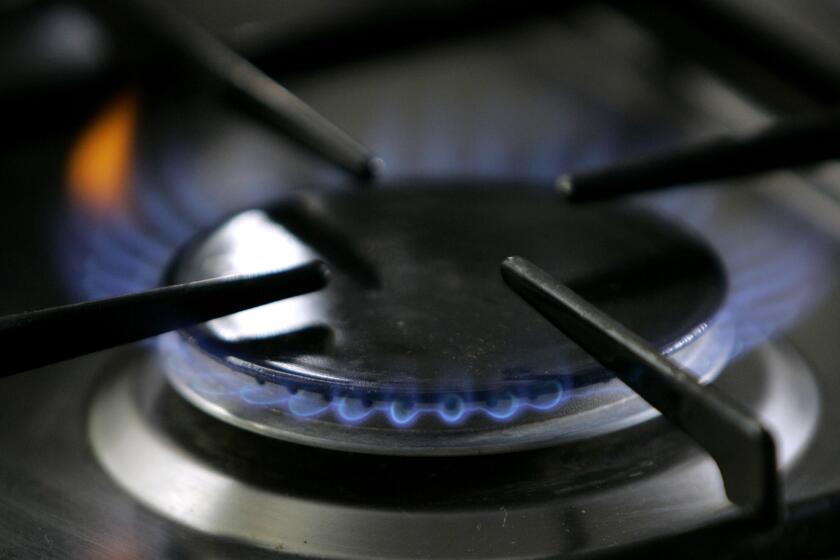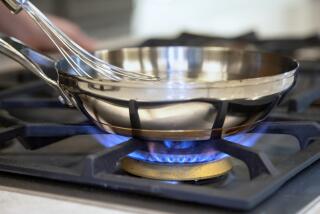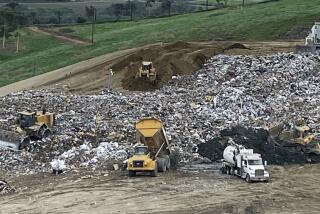Opinion: Don’t worry about the government taking your gas stove — worry about the pollution inside your home
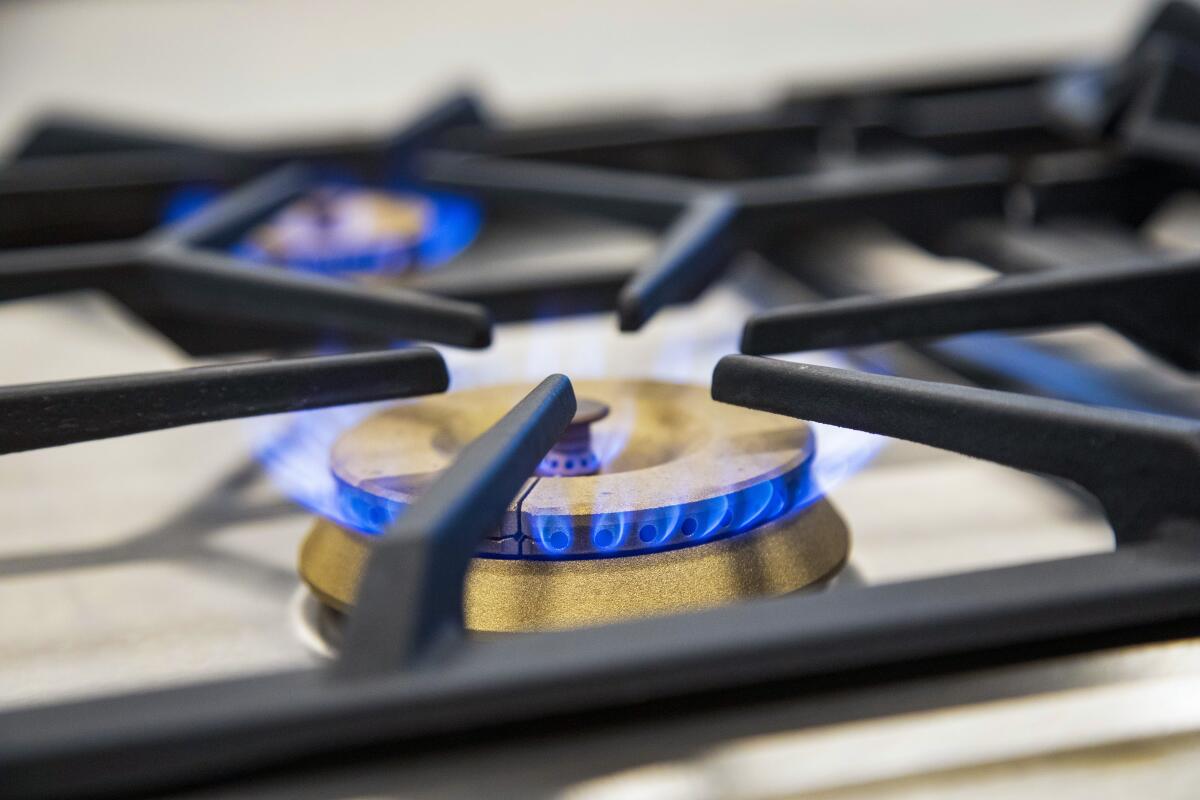
- Share via
As a pediatrician, a big part of my work is to advise families on nutrition and healthy eating. These days, I find myself talking with parents and patients more often about how they prepare their food — as in what appliances they are using to cook.
A number of studies in recent years have examined the dangers of having a gas stove in the home. They have addressed questions such as how common gas leaks from stoves really are (very common); what’s in natural gas besides methane (21 hazardous air pollutants); do these pollutants leak into our homes (they do); and do gas stoves really cause asthma (yes, about 12.7% of childhood asthma is attributed to them). All of this research shows serious harm to children and their families.
Now, in a new study from Stanford, researchers turned the stove on, testing indoor air quality under a number of common cooking situations. The results are alarming. These scientists tested several scenarios: They lit a single burner for 45 minutes — roughly how long it takes to make chicken soup. They turned the oven on to 350 degrees for 45 minutes — a common cooking setting for lasagna. They also set the oven to 475 degrees for 90 minutes — approximately the length of time it takes to preheat the oven and roast a chicken. This research found that burning gas or propane to make these staple meals created dangerous pollution inside — and not just in the kitchen, but throughout the whole house, for hours.
There is no federal plan to ban gas stoves. But it is clear that they are harmful sources of indoor air pollution and should be phased out.
Specifically, these scientists were measuring benzene emissions. Benzene is a highly toxic chemical used to make plastics, pesticides and other chemical compounds. It can be found in gasoline and cigarette smoke. Benzene affects our bone marrow, damages our immune systems and impairs our ability to produce red blood cells. Exposure to it is linked to anemia and blood cancers such as leukemia. Benzene is not something we want where we eat and sleep.
The study found that cooking with gas or propane releases between 50 and 500 times as much benzene into homes as is leaked from stoves when they are off. Turning on one burner for 45 minutes created benzene levels in kitchens comparable to breathing in cigarette smoke. The benzene then drifted through the house and was detectable in bedrooms far from the kitchen.
The levels were high enough that an immediate investigation would have been triggered had they been measured in public outdoor spaces, such as one in 2020 after an outdoor air monitor in a parking lot across from North High School in Torrance, about a quarter mile from the Torrance Gas Refinery, recorded a reading of 8.84 parts per billion. This was a lower level of benzene than researchers found in a bedroom of one of the homes they tested after cooking with a gas stove.
Why do we launch investigations when benzene is detected in unsafe levels outside, but view comparable pollution from burning gas inside as normal? It’s because there are no indoor air quality standards for homes, even though that’s where we spend most of our time. And the gas industry has spent decades waging an expensive public relations campaign to get the public to believe that cooking with gas is good, while covering up their own research showing the harms that come from burning fossil fuels indoors.
Although everyone is at risk from these dangers, we should be especially concerned about people who live in rental apartments or in affordable housing.
Republicans are pushing two bills that would prevent a federal ban on gas stoves, though the Biden administration hasn’t announced any plans to prohibit the appliances.
Building owners are not incentivized to update appliances, living space can be tight and ventilation may be limited, which means that concentrations of benzene and other harmful stove pollutants such as nitrogen dioxide can build up faster and stay in the air longer. The harm of fossil fuel pollution is cumulative. People who live in affordable or public housing are also often at the highest risk of breathing in outdoor pollution, because of discriminatory housing practices that located polluting industrial facilities near neighborhoods where more people of color and poor people live.
The consumer rebates offered through the Inflation Reduction Act to swap gas stoves for electric ones might be helpful to some people but don’t go far enough. These rebates are out of reach for the people who would benefit most. We need policies that prioritize the health of those who live in rental housing. Replacing gas appliances with electric ones is just one part of investing in safe, clean and sustainable homes.
So, what can people do now? Even if a kitchen has an over-oven fan or vent, research shows that these features are unreliable in getting out gas pollution. Those who have them should turn them on anyway, but everyone should open windows throughout their homes when cooking or baking — and leave them open afterward. This creates ways for pollutants to flow out of living spaces.
We can also reduce our reliance on gas stoves by investing in lower-cost electric products such as plug-in kettles, coffee makers, electric toaster ovens, slow cookers and microwaves, all of which will keep homes cleaner, safer and cooler.
Cooking should be something that creates nourishment and brings families together. Instead, the common gas stove is causing industrial pollution in our homes that is threatening everyone’s health.
Lisa Patel is a pediatric hospitalist, environmental scientist and executive director for the Medical Society Consortium on Climate and Health.
More to Read
A cure for the common opinion
Get thought-provoking perspectives with our weekly newsletter.
You may occasionally receive promotional content from the Los Angeles Times.
